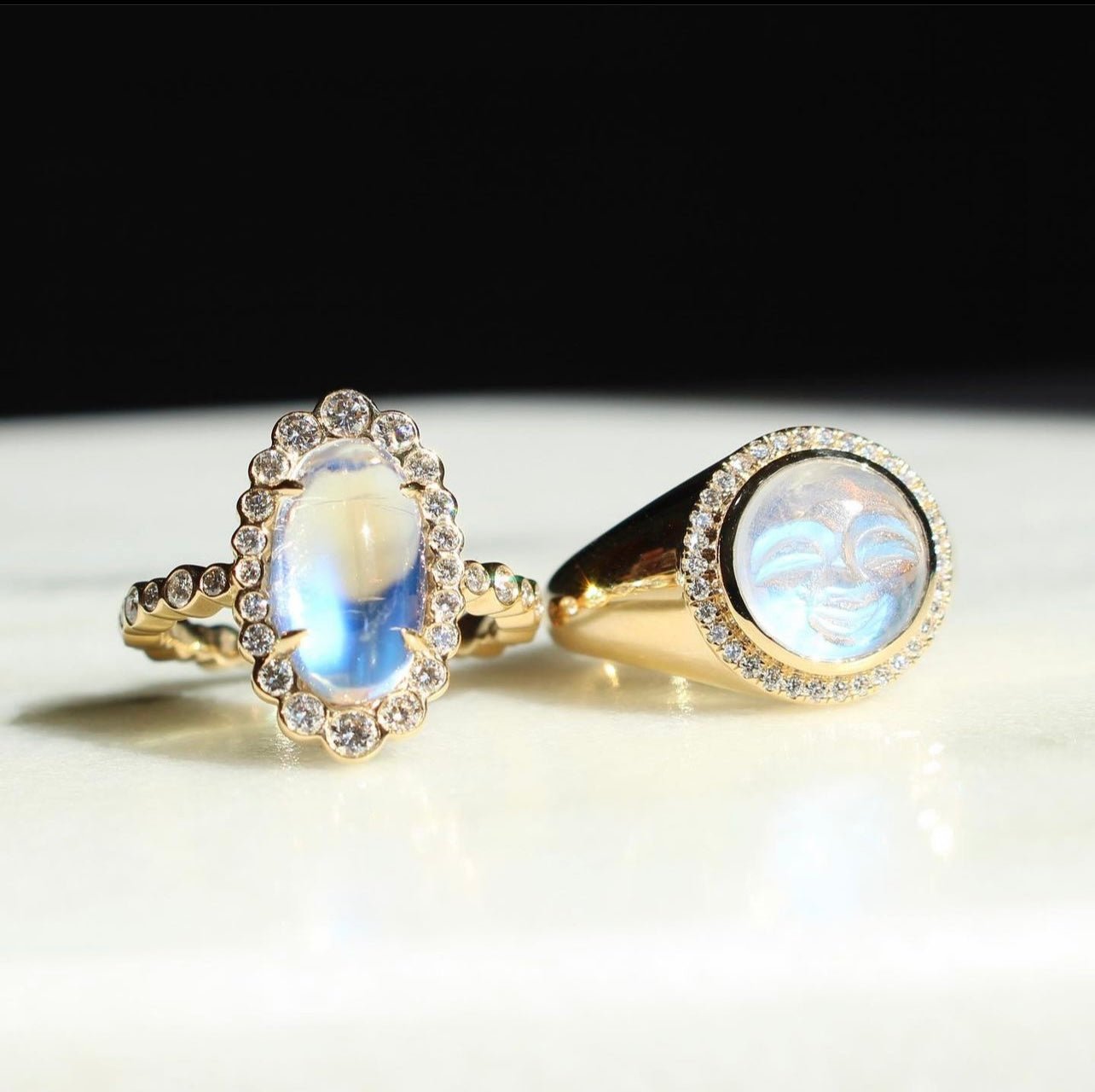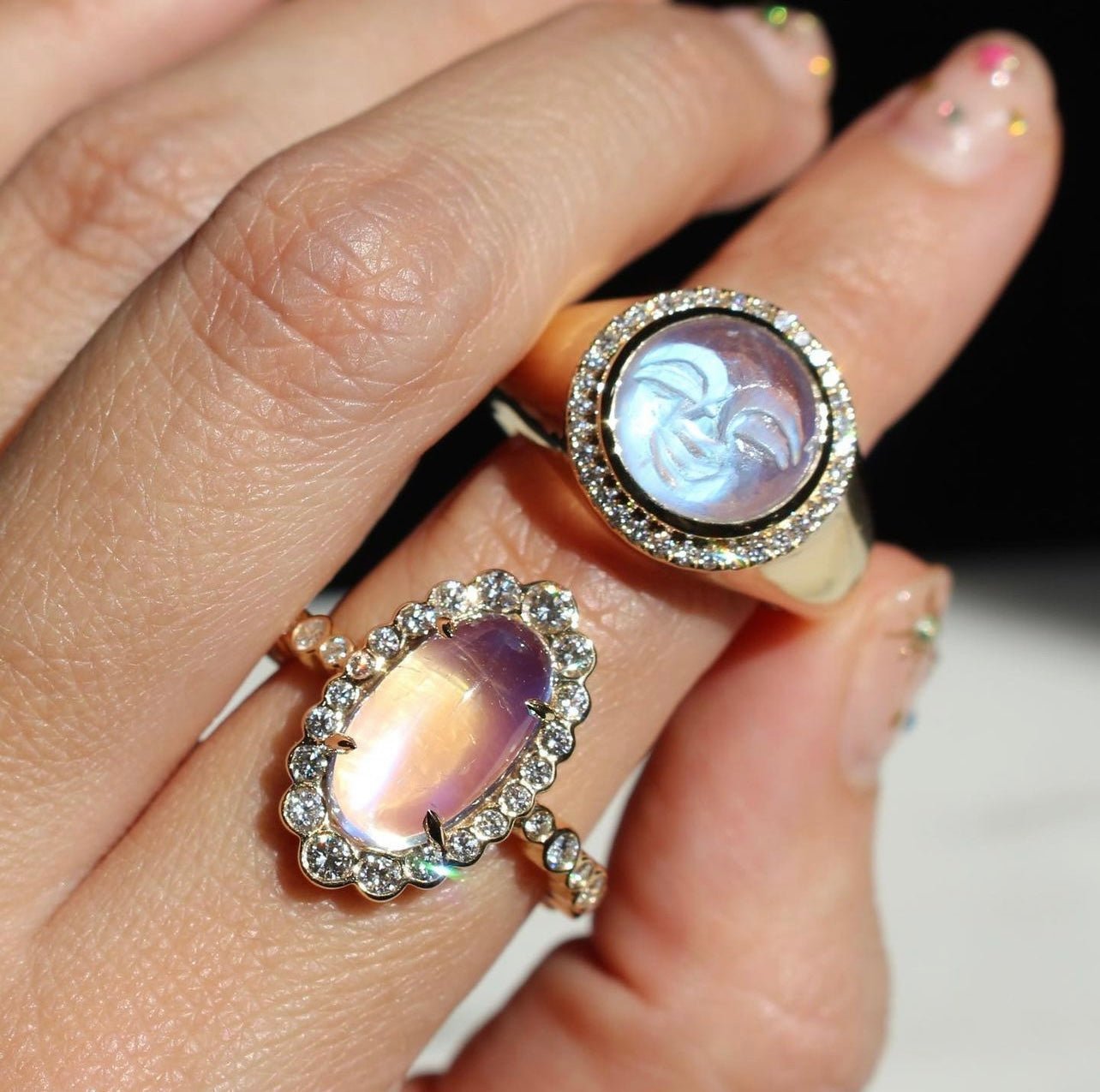It’s a tale that we all know - one partner gets down on their knee to pop the big question while the other fawns in disbelief, clutching their hands to their mouth and bubbling with emotion. This is the moment they’ve been waiting for, and the next is the grand reveal of what they will be gifted - a diamond. Or is it?
Diamonds are the most typical stone set inside of an engagement ring. Maybe it is because they are rumored to be so rare (have you ever heard some say you’re a diamond in the rough?). Or maybe it is because they are believed to be so resistant to wear and tear with a 10 on the Mohs scale.
We’ll challenge both of these beliefs later on. Whatever the reasoning, it is indisputable that one would expect to see the glimmer of a diamond when their partner pops the special question, per alignment with tradition,
However, we know you’re more than just tradition.
Modern-day love stories deserve something a little more unique and a lot more personal, especially since it is well known that engagement rings are often passed down for generations to come.
Here is your ultimate guide to diamond replacements for your special day.
Exotic Gems: The Value and Meaning
At Mark Henry Jewelry, we take immense pride in our sale and cultivation of an expansive exotic gem collection. We source our finds with mines from Brazil to Mozambique, always on the cutting edge of what the market is leaning towards while maintaining an allegiance to the beauty of truly fine and timeless pieces.
We firmly believe that diamonds pale in comparison to exotic gems for many reasons, one being their masqueraded rarity.
How many people do you know who have been or are engaged and boast a sparkly diamond on their fourth finger? We’d be willing to bet most do.
The genuine rarity of exotic stones does instead amplify their price, but it also amplifies the pull from collectors to snatch them up. That is why we are so committed to using valuable gems in our designs so they can be accessible to a wider audience of consumers.
The Highest Quality
When it comes to diamond alternatives, not all stones are made equally. Your budget and understanding of natural gems will guide you in determining what to purchase and what may not be worth your investment.
Here are a few exotic and rare stones to consider:
Alexandrite
We have to emphasize the importance of this gem before we unwrap any others due to its incredible meaning to our company. Alexandrite is known for its color-changing properties, going from a green tone in daylight to a beautiful red under incandescent light.
It was discovered in the Ural Mountains of Russia in the 1830s and came to widespread value when it transcended regional mining and was discovered across the world.

We cut this gem in varieties of designs, including everything from classical forms in rings to geometric facets to bring out its properties. With a hardness of 8.5 on the Mohs scale, it is incredibly durable and known to withstand standard cleaning procedures and being placed in rings just as well as diamonds.
Paraíba Tourmaline
While regular tourmaline comes in a variety of colors, the type discovered in Paraíba, Brazil in the 1980s rivaled any other - a brilliant neon-blue shade flashes from this stone.

Mark Henry Jewelry favors paríba tourmaline for its rarity and vivid colors, which can include hints of green or violet. The color is accredited to trace amounts of copper. It is priced similarly to sapphire, and we love to place them side by side in our designs among some 18k white or yellow gold.
With a hardness of 7-7.5 on the Mohs scale, it is definitely not soft but not as durable as a traditional diamond. However, it presents with no cleavage, so it is unlikely to split if it were bumped around as a ring.
Cat’s Eye Chrysoberyl
While rare, alexandrite can fall into this category. These gems, in general, present with chatoyancy. This is an effect that splits the piece in half, with one side resembling the look of honey and one resembling milk and an oval-shaped splotch of color in the middle.
They occur in yellow-green or plain yellow and are frequently cut into cabochons to preserve their unique presentation. As an 8.5 on the Mohs scale, they are available for versatile use and could resist ultrasonic or mechanical cleaning.
“Jedi” Spinels
If your partner is looking for something really off the beaten path, or they’re simply a huge fan of Star Wars, this neon-pink gem is for them.
First found in Myanmar in 2001, Jedi Spinels do not present “dark side” tones, thus their pop-culture name. Their glow comes from high iron content, rivaling the shine of a diamond with something far more show-stopping.
While incredibly valuable, they are not necessarily popular, and that contributes to a lower price range than other exotic gems.
Turquoise
This gem is fascinating to look at and to read up on. Popularized across Europe and Asia and then found in Southwestern America, turquoise is known for bright robin’s egg blue hues and speckled matrix.
It comes in so many variations that there is truly a gem for everyone - from White Buffalo turquoise with dark black matrix to yellow turquoise.
This gem also varies in hardness quite significantly, and of course, the softer the material, the more difficult it is to hold up well inside of a ring. Wax and resin seals are common in the stabilization process, giving it a longer shelf life, albeit taking away some of its raw value.
In terms of meaning, turquoise is admired as a stone of healing for the Native American people, with some tribes even using it medicinally, specifically regarding blood and circulatory issues.
At Mark Henry Jewelry, we are lucky enough to have access to pieces from the now-closed Sleeping Beauty Mine, which are the rarest and highest quality in the world.
Price-Conscious Options
Of course, some purchasing engagement rings are not looking for too much of an investment. Life does happen, and sometimes diamonds (and partnerships) are not forever.
In that case - or if you’re simply trying to save some extra bucks on the ring to make up for it at the ceremony - you should know that while diamonds are incredibly expensive they are also not necessarily worth their hefty price tags due to their large accessibility.
Here are some alternatives to research:
-
Lab-Made: Diamonds that are synthetically processed often look identical to what they’re emulating. The difference can be so hard to tell that only mineralogists and jewelers would ever find out. Moissanite is lab-created and typically on the cheaper end. Cubic Zirconia is also created in a lab and is regarded as highly popular, even reflecting more light than real diamonds.
However, they have poor wearability, and oil from your skin can dull their shine.
-
White Sapphire: While blue sapphire is easier to spot, this gem also comes in a light, white shade! It doesn’t quite sparkle the same way that its colorful counterpart does or the way a diamond might, but it offers a more subdued look.
- White Zircon: Cubic Zirconia may be entirely synthetic, but white zircon is not. Classified as a natural gem, it is the most visually similar to diamonds out of any other raw gem. It can be quite breakable, and its low durability is marked by its more affordable price.
What To Look For
If you are planning to replace a classic ring design with one of the options above, you should consider some of the basic properties of diamonds that you may want to keep across the board. As we mentioned before, diamonds do rank as a 10 on the Mohs scale.
While this doesn’t protect them from all cracks and cuts, anything that falls below a 7 on the scale might need to be reconsidered for ring placement if it cannot be enhanced.
For example, pearls are incredibly classic and traditional, making great additions to wedding and engagement rings, but they’re very easy to scratch as a 0.25-4.5 on the Mohs scale.
Considering that dust in a home can rank as a 7 on the scale, be careful if your gem could be potentially ruined from trivial bumps and bruises - especially if you’re investing monetarily.
Saying “I Do”
When you plan out what to say before your dream proposal, maybe you never imagined what shape that beautiful cut would take inside of the black box in your hand.
On the other hand, maybe you’ve never paid much mind to the carat size or sheen of what will grace your left hand for a lifetime. Allow us to offer ethically-sourced and transparently processed gems that are perfect for rings.
Don’t be swayed by tradition or public opinion when making your purchase if you truly want something a little different. This is your ring, and you ought to love it. Ingenuity can make quite a unique statement.
Sources:
What's the Best Diamond Alternative? | Gem Society
Ten Rare and Expensive Engagement Ring Stones | Gem Society
20 Diamond-Alternative Gemstones for Engagement Rings | Bridal Musings


